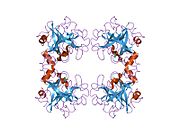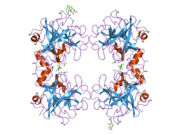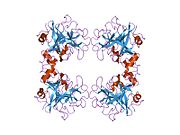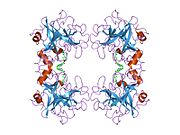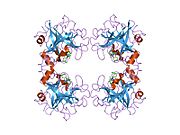TPSB2
| TPSB2 | |||||||||||||||||||||||||||||||||||||||||||||||||||
|---|---|---|---|---|---|---|---|---|---|---|---|---|---|---|---|---|---|---|---|---|---|---|---|---|---|---|---|---|---|---|---|---|---|---|---|---|---|---|---|---|---|---|---|---|---|---|---|---|---|---|---|
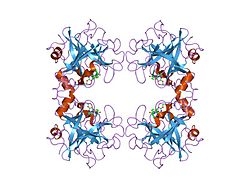 | |||||||||||||||||||||||||||||||||||||||||||||||||||
| |||||||||||||||||||||||||||||||||||||||||||||||||||
| Identifiers | |||||||||||||||||||||||||||||||||||||||||||||||||||
| Aliases | TPSB2, TPS2, tryptaseB, tryptaseC, tryptase beta 2 (gene/pseudogene), tryptase beta 2 | ||||||||||||||||||||||||||||||||||||||||||||||||||
| External IDs | OMIM: 191081; MGI: 96942; HomoloGene: 55729; GeneCards: TPSB2; OMA:TPSB2 - orthologs | ||||||||||||||||||||||||||||||||||||||||||||||||||
| |||||||||||||||||||||||||||||||||||||||||||||||||||
| |||||||||||||||||||||||||||||||||||||||||||||||||||
| |||||||||||||||||||||||||||||||||||||||||||||||||||
| |||||||||||||||||||||||||||||||||||||||||||||||||||
| |||||||||||||||||||||||||||||||||||||||||||||||||||
| Wikidata | |||||||||||||||||||||||||||||||||||||||||||||||||||
| |||||||||||||||||||||||||||||||||||||||||||||||||||
Tryptase beta-2, also known as tryptase II, is a proteolytic enzyme that in humans is encoded by the TPSB2 gene.[5]
Formerly, the enzyme was known as Tryptase Clara.
Function
Tryptases comprise a family of trypsin-like serine proteases, the peptidase family S1. Tryptases are enzymatically active only as heparin-stabilized tetramers, and they are resistant to all known endogenous proteinase inhibitors.
Several tryptase genes are clustered on chromosome 16p13.3. These genes are characterized by several distinct features. They have a highly conserved 3'-UTR and contain tandem repeat sequences at the 5' flank and 3' UTR which are thought to play a role in regulation of the mRNA stability. These genes have an intron immediately upstream of the initiator Met codon, which separates the site of transcription initiation from protein coding sequence. This feature is characteristic of tryptases but is unusual in other genes. The alleles of this gene exhibit an unusual amount of sequence variation, such that the alleles were once thought to represent two separate genes, beta II and beta III.
Beta tryptases appear to be the main isoenzymes expressed in mast cells and club cells, whereas in basophils, alpha-tryptases predominate.
Tryptases have been implicated as mediators in the pathogenesis of asthma and other allergic and inflammatory disorders.[5] In particular, influenza A virus is activated by TPSB2-mediated proteolytic cleavage in the upper respiratory tract.[6]
References
- ^ a b c GRCh38: Ensembl release 89: ENSG00000197253 – Ensembl, May 2017
- ^ a b c GRCm38: Ensembl release 89: ENSMUSG00000033825 – Ensembl, May 2017
- ^ "Human PubMed Reference:". National Center for Biotechnology Information, U.S. National Library of Medicine.
- ^ "Mouse PubMed Reference:". National Center for Biotechnology Information, U.S. National Library of Medicine.
- ^ a b "Entrez Gene: tryptase beta 2 (gene/pseudogene)".
- ^ Kido H, Yokogoshi Y, Sakai K, Tashiro M, Kishino Y, Fukutomi A, Katunuma N (July 1992). "Isolation and characterization of a novel trypsin-like protease found in rat bronchiolar epithelial Clara cells. A possible activator of the viral fusion glycoprotein". The Journal of Biological Chemistry. 267 (19): 13573–13579. doi:10.1016/S0021-9258(18)42250-8. PMID 1618859.
Further reading
- Miller JS, Moxley G, Schwartz LB (September 1990). "Cloning and characterization of a second complementary DNA for human tryptase". The Journal of Clinical Investigation. 86 (3): 864–870. doi:10.1172/JCI114786. PMC 296804. PMID 2203827.
- Hallgren J, Lindahl S, Pejler G (January 2005). "Structural requirements and mechanism for heparin-dependent activation and tetramerization of human betaI- and betaII-tryptase". Journal of Molecular Biology. 345 (1): 129–139. doi:10.1016/j.jmb.2004.10.029. PMID 15567416.
- Sommerhoff CP, Bode W, Matschiner G, Bergner A, Fritz H (March 2000). "The human mast cell tryptase tetramer: a fascinating riddle solved by structure". Biochimica et Biophysica Acta (BBA) - Protein Structure and Molecular Enzymology. 1477 (1–2): 75–89. doi:10.1016/s0167-4838(99)00265-4. PMID 10708850.
- Huang C, Li L, Krilis SA, Chanasyk K, Tang Y, Li Z, et al. (July 1999). "Human tryptases alpha and beta/II are functionally distinct due, in part, to a single amino acid difference in one of the surface loops that forms the substrate-binding cleft". The Journal of Biological Chemistry. 274 (28): 19670–19676. doi:10.1074/jbc.274.28.19670. PMID 10391906.
- Caughey GH, Raymond WW, Blount JL, Hau LW, Pallaoro M, Wolters PJ, Verghese GM (June 2000). "Characterization of human gamma-tryptases, novel members of the chromosome 16p mast cell tryptase and prostasin gene families". Journal of Immunology. 164 (12): 6566–6575. doi:10.4049/jimmunol.164.12.6566. PMID 10843716.
- Vanderslice P, Ballinger SM, Tam EK, Goldstein SM, Craik CS, Caughey GH (May 1990). "Human mast cell tryptase: multiple cDNAs and genes reveal a multigene serine protease family". Proceedings of the National Academy of Sciences of the United States of America. 87 (10): 3811–3815. Bibcode:1990PNAS...87.3811V. doi:10.1073/pnas.87.10.3811. PMC 53993. PMID 2187193.
- Guida M, Riedy M, Lee D, Hall J (July 2000). "Characterization of two highly polymorphic human tryptase loci and comparison with a newly discovered monkey tryptase ortholog". Pharmacogenetics. 10 (5): 389–396. doi:10.1097/00008571-200007000-00002. PMID 10898108.
- Blom T, Hellman L (February 1993). "Characterization of a tryptase mRNA expressed in the human basophil cell line KU812". Scandinavian Journal of Immunology. 37 (2): 203–208. doi:10.1111/j.1365-3083.1993.tb01757.x. PMID 8434231. S2CID 22041090.
- Pallaoro M, Fejzo MS, Shayesteh L, Blount JL, Caughey GH (February 1999). "Characterization of genes encoding known and novel human mast cell tryptases on chromosome 16p13.3". The Journal of Biological Chemistry. 274 (6): 3355–3362. doi:10.1074/jbc.274.6.3355. PMID 9920877.
- Caughey GH (September 2002). "New developments in the genetics and activation of mast cell proteases". Molecular Immunology. 38 (16–18): 1353–1357. doi:10.1016/S0161-5890(02)00087-1. PMID 12217407.
- Akin C, Soto D, Brittain E, Chhabra A, Schwartz LB, Caughey GH, Metcalfe DD (June 2007). "Tryptase haplotype in mastocytosis: relationship to disease variant and diagnostic utility of total tryptase levels". Clinical Immunology. 123 (3): 268–271. doi:10.1016/j.clim.2007.02.007. PMC 1949411. PMID 17449330.
- Sommerhoff CP, Bode W, Pereira PJ, Stubbs MT, Stürzebecher J, Piechottka GP, et al. (September 1999). "The structure of the human betaII-tryptase tetramer: fo(u)r better or worse". Proceedings of the National Academy of Sciences of the United States of America. 96 (20): 10984–10991. Bibcode:1999PNAS...9610984S. doi:10.1073/pnas.96.20.10984. PMC 34230. PMID 10500112.
- Daniels RJ, Peden JF, Lloyd C, Horsley SW, Clark K, Tufarelli C, et al. (February 2001). "Sequence, structure and pathology of the fully annotated terminal 2 Mb of the short arm of human chromosome 16". Human Molecular Genetics. 10 (4): 339–352. doi:10.1093/hmg/10.4.339. PMID 11157797.
- Trivedi NN, Tamraz B, Chu C, Kwok PY, Caughey GH (November 2009). "Human subjects are protected from mast cell tryptase deficiency despite frequent inheritance of loss-of-function mutations". The Journal of Allergy and Clinical Immunology. 124 (5): 1099–1105.e4. doi:10.1016/j.jaci.2009.07.026. PMC 2783561. PMID 19748655.
- Pereira PJ, Bergner A, Macedo-Ribeiro S, Huber R, Matschiner G, Fritz H, et al. (March 1998). "Human beta-tryptase is a ring-like tetramer with active sites facing a central pore". Nature. 392 (6673): 306–311. Bibcode:1998Natur.392..306P. doi:10.1038/32703. PMID 9521329. S2CID 4421972.
- Wu C, Ma MH, Brown KR, Geisler M, Li L, Tzeng E, et al. (June 2007). "Systematic identification of SH3 domain-mediated human protein-protein interactions by peptide array target screening". Proteomics. 7 (11): 1775–1785. doi:10.1002/pmic.200601006. PMID 17474147. S2CID 22474278.
This article incorporates text from the United States National Library of Medicine, which is in the public domain.






